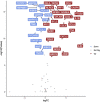Inflammasome Activity in Response to Influenza Vaccination Is Maintained in Monocyte-Derived Peripheral Blood Macrophages in Older Adults
- PMID: 35822051
- PMCID: PMC9261430
- DOI: 10.3389/fragi.2021.719103
Inflammasome Activity in Response to Influenza Vaccination Is Maintained in Monocyte-Derived Peripheral Blood Macrophages in Older Adults
Abstract
Introduction: Each year, a disproportionate number of the total seasonal influenza-related hospitalizations (90%) and deaths (70%) occur among adults who are >65 years old. Inflammasome activation has been shown to be important for protection against influenza infection in animal models but has not yet been demonstrated in humans. We hypothesized that age-related dysfunction (immunosenescence) of the inflammasome may be associated with poor influenza-vaccine response among older adults. Methods: A cohort of younger (18-40 years of age) and older (≥65 years of age) adults was recruited prior to the 2014-2015 influenza season. We measured hemagglutination inhibition (HAI) titers in serum before and 28 days after receipt of the seasonal inactivated influenza vaccine. Inflammasome-related gene expression and protein secretion were quantified in monocyte-derived macrophages following stimulation with influenza A/H1N1 virus. Results: Younger adults exhibited higher HAI titers compared to older adults following vaccination, although inflammasome-related protein secretion in response to influenza stimulation was similar between the age groups. Expression of P2RX7 following influenza stimulation was lower among older adults. Interestingly, CFLAR expression was significantly higher among females (p = 2.42 × 10-5) following influenza stimulation and this gene may play an important role in the development of higher HAI antibody titers among older females. Conclusion: Inflammasome activation in response to influenza vaccination appears to be maintained in monocyte-derived macrophages from older adults and does not explain the poor influenza vaccine responses generally observed among this age group.
Keywords: NLRP3; aging; inflammasome; influenza; vaccination.
Copyright © 2021 Crooke, Goergen, Ovsyannikova and Kennedy.
Conflict of interest statement
IO hold three patents related to measles and vaccinia peptide research. RK holds a patent on vaccinia peptide research. RK and IO have received grant funding from ICW Ventures for preclinical studies on a peptide-based COVID-19 vaccine. RK has received funding from Merck Research Laboratories to study waning immunity to measles and mumps after immunization with the MMR-II® vaccine. This research has been reviewed by the Mayo Clinic Declaration of Competing Interest Review Board and was conducted in compliance with Mayo Clinic Declaration of Competing Interest policies. The remaining authors declare that the research was conducted in the absence of any commercial or financial relationships that could be construed as a potential conflict of interest.
Figures



Similar articles
-
The Effect of Influenza Vaccination History on Changes in Hemagglutination Inhibition Titers After Receipt of the 2015-2016 Influenza Vaccine in Older Adults in Hong Kong.J Infect Dis. 2020 Jan 1;221(1):33-41. doi: 10.1093/infdis/jiz327. J Infect Dis. 2020. PMID: 31282541
-
Key Determinants of Cell-Mediated Immune Responses: A Randomized Trial of High Dose Vs. Standard Dose Split-Virus Influenza Vaccine in Older Adults.Front Aging. 2021 May;2:649110. doi: 10.3389/fragi.2021.649110. Epub 2021 May 21. Front Aging. 2021. PMID: 35128529 Free PMC article.
-
Immune responses to intradermal and intramuscular inactivated influenza vaccine among older age group.Vaccine. 2017 Dec 19;35(52):7339-7346. doi: 10.1016/j.vaccine.2017.10.106. Epub 2017 Nov 20. Vaccine. 2017. PMID: 29157960 Clinical Trial.
-
Vitamin E, vitamin A, and zinc status are not related to serologic response to influenza vaccine in older adults: an observational prospective cohort study.Nutr Res. 2014 Feb;34(2):149-54. doi: 10.1016/j.nutres.2013.12.004. Epub 2013 Dec 18. Nutr Res. 2014. PMID: 24461316
-
Antibody Response and Protection After Receipt of Inactivated Influenza Vaccine: A Systematic Review.Pediatrics. 2021 Jun;147(6):e2020019901. doi: 10.1542/peds.2020-019901. Pediatrics. 2021. PMID: 34039716
Cited by
-
Genome-wide siRNA library screening identifies human host factors that influence the replication of the highly pathogenic H5N1 influenza virus.mLife. 2025 Feb 24;4(1):55-69. doi: 10.1002/mlf2.12168. eCollection 2025 Feb. mLife. 2025. PMID: 40026577 Free PMC article.
-
Inflammasome Contribution to the Activation of Th1, Th2, and Th17 Immune Responses.Front Microbiol. 2022 Mar 17;13:851835. doi: 10.3389/fmicb.2022.851835. eCollection 2022. Front Microbiol. 2022. PMID: 35369454 Free PMC article. Review.
References
-
- Centers for Disease Control and Prevention (CDC) (2010). Estimates of Deaths Associated with Seasonal Influenza-United States, 1976-2007. Morbidity Mortality Weekly Rep. 59 (33), 1057–1062. - PubMed
-
- Chen W. H., Cross A. S., Edelman R., Sztein M. B., Blackwelder W. C., Pasetti M. F. (2011). Antibody and Th1-type Cell-Mediated Immune Responses in Elderly and Young Adults Immunized with the Standard or a High Dose Influenza Vaccine. Vaccine 29, 2865–2873. 10.1016/j.vaccine.2011.02.017 - DOI - PMC - PubMed
LinkOut - more resources
Full Text Sources
Miscellaneous

